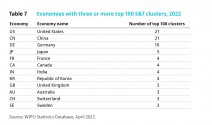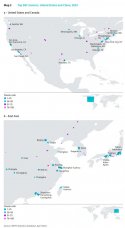You are using an out of date browser. It may not display this or other websites correctly.
You should upgrade or use an alternative browser.
You should upgrade or use an alternative browser.
News on China's scientific and technological development.
- Thread starter Quickie
- Start date
have you ever tried Deepin ?As I wrote over three years ago, China must replace Windows with a local operating system. Microsoft's long relationship with the US's spies is well known.
its been posted many pages agoi don't remember it being posted here:
this one is new, however:
Asia take top 7 out of top 10 positions. China gets 3.
China is #1 where it matters in chemistry and physics.Some months old, but i don't remember it being posted here:
View attachment 97732
US is slightly ahead in environmental sciences (important but lots of environmental science is published in chemistry/physics)
US only has a major lead in life science.
However life science research in that country is highly questionable due to the plethora of non reproducible AKA fake or wrong papers.
This is well known by industry which is why even though STEM is heavily pushed by the regime, biology graduates make less money than liberal arts majors.
It is also about 6G standardization. Samsung, Ericsson etc can discuss and compete with Huawei freely in setting the standard. Qualcomm is barred by US to be involved with Huawei in any way. That isolates any US company instead of Huawei.If im not mistaken Huawei has introduced a file system standard for mobile apps.
That recently got merged into android, wouldn't be surprised if Huawei will create application standards with open Harmony apps.
Kind of like flatpacks, AppImage etc you have right now for Linux.
It is another demonstration that US' China containment only isolate itself.
Oh! It seems that the Global Innovation Index will be released on 29th of September.its been posted many pages ago
this one is new, however:
Asia take top 7 out of top 10 positions. China gets 3.
Nature Index and this one are what I pay attention to
From the above pre-released chapter, China now has an equal number of S&T clusters as the US.
And it seems that this year they merged Shanghai and Suzhou into one cluster.


Can anyone please explain what is going on here?
China’s top weapons scientist says nuclear fusion power is 6 years away
Topic |
- Peng Xianjue unveils plans for combined fusion-fission reactor that could make China world’s first to achieve the elusive viable energy source
- No country has so far managed to build a facility that generates more power than it uses in the fission process
The Chinese government has approved construction of the world’s largest pulsed-power plant with plans to generate energy by 2028, according to the top nuclear weapons scientist leading the project.
“Fusion ignition is the jewel in the crown of science and technology in today’s world,” said Peng Xianjue, a professor with the Chinese Academy of Engineering Physics, in an online meeting organised by Beijing-based think tank Techxcope on September 9.
“Being the world’s first to achieve energy-scale fusion energy release will lay the most important milestone in the road to fusion energy for human beings.”
Peng, 81, has developed some of China’s most advanced small nuclear warheads and served as a top adviser to the country’s nuclear weapons programme, according to openly available information.
The Z-pinch machine – which replicates the fusion reactions of a thermonuclear bomb through magnetic pressure created by an extremely strong electric pulse – is expected to be completed around 2025 in Chengdu, Sichuan province in southwest China.
The machine will produce 50 million amperes of electricity – about twice as much as the record-holding Z pulsed power facility, a similar device at the Sandia National Laboratory in the US, Peng said.
Nuclear powers like the US, Russia and China have built a number of Z-pinch machines over the past few decades – some of which have never been officially disclosed – to simulate the extreme conditions needed to develop atomic weapons.These facilities can store a huge amount of electricity and release it in just a few nanoseconds. The electric pulse can create extreme pressure and enough radiation for two lightweight atoms to “fuse” into a heavier one, and give up some mass in the form of energy.
But building a machine that can produce more fusion power output than input is extremely difficult and so far, no country has been successful.
According to Peng’s presentation, the Chinese researchers will try to create a nuclear fusion reaction by using the strong electric charge to ignite a small number of hydrogen isotopes deuterium and tritium.
By carefully controlling the process, they hope to be able to cap the pulse energy released to a few hundred million joules – about as powerful as a 20kg (44lbs) bag of TNT.
And in a departure from previous designs, the fusion energy produced by the Chinese facility will not go to the power grid, but drive a swamp of superfast particles to hit uranium – the fuel which will power the facility’s fission component.
In his conference presentation, Peng said this inclusion of fusion and fission reactors is responsible for the Chinese design’s designation as Z-FFR.
The intention is for the walls of the fusion ignition chamber to be filled with uranium which will absorb the flying neurons produced by the explosion, causing it to split into two lighter elements – the same process used in existing nuclear power facilities.
The uranium fission will increase the facility’s total heat output by 10 to 20 times, significantly accelerating the application of fusion energy and making it ready for commercial power production by 2035, according to an estimate by Peng’s team.
If China’s machine is to succeed, it will need many high-performance capacitors to store the electricity and laser-powered switches that can operate instantly without causing a shortage.
Other challenges include special wires able to transmit the strongest electric currents on Earth, and a peanut-sized target device to efficiently convert electricity to ignition charge.
Peng said many of these problems had been solved, thanks to new scientific discoveries and technical breakthroughs by Chinese nuclear scientists in recent years. And some of their approaches are fundamentally different from what has been tried in the West.
In its fusion experiments, the Sandia lab tried to start ignition from the centre of the target device. But the Chinese researchers say they have found ignition could more easily be achieved by first creating a thin line of fusion reactions that runs through the target’s centre.
This linear approach reduces the complex, three-dimensional problem of squeezing the entire target – at equal pressure from many directions simultaneously – to a one-dimensional issue, Peng said.
The Chinese approach significantly simplifies the physical models for computer analysis while relaxing the demand for energy input, he said. “This is a big innovation.”
The researchers said the future power plant could use natural uranium ore, the nuclear waste produced by today’s reactors, or thorium, which could meet energy demand for thousands – or even tens of thousands – of years while producing little radioactive waste.
And because the fusion explosion will happen only once every 10 seconds, it will be incapable of generating enough energy to start a chain reaction and cause a meltdown, making the design safe and suitable for most places on Earth, they said.
The Z machine is just one of a range of methods – including powerful lasers and hot plasma caged in a magnetic field – being tried and tested by China and other countries in the race to achieve fusion ignition.
A number of giant facilities are in development around the world, with most aiming for commercial power production by the middle of this century.
A Beijing-based nuclear physicist, who asked not to be named because of the issue’s sensitivity, said that while the Z machine has some unique advantages, it also presents some difficult problems that may affect its mass application.
The electric power source, for instance, will need to generate and release charges at a high frequency every few seconds, putting an enormous strain on the capacitors and other components, the physicist said.
In addition, the target device will need to be replaced after each explosion, while the reactor chamber will need to withstand thousands of explosive shocks per day.
But whether ignition can be achieved, one thing is certain, according to the physicist: the facility will be a “mega lab” for cutting edge research on everything from Big Bang physics to new weapons.
It is NOT Fusion reactor.Nuclear fusion is the holy grail of energy. this is hugeeeeeeee breakthrough.
China’s top weapons scientist says nuclear fusion power is 6 years away
- Peng Xianjue unveils plans for combined fusion-fission reactor that could make China world’s first to achieve the elusive viable energy source
- No country has so far managed to build a facility that generates more power than it uses in the fission process
Here is the paper in question
The reactor is hybrid. It has a small fusion device to generate fast neutrons to bombard natural uranium in a fission reactor. The fission reactor is where most the emerge is generated. The fission reactor also generate Tritium which is fed back to the fusion device as fuel. The fusion device is actually creating some continues explosions.
In essence,
- The fusion in this setup is NOT the source of energy. The output of the fusion process is still NEGATIVE in energy generation.
- The energy is generated by fission process, therefor it is a fission reactor but hybrid.
- Use raw Uranian instead of enriched. Cost saving and safe.
- Utilize 80% uranium in the raw ore. Can be 200 years without refueling. Much less radioactive waste compared to conventional reactor.
- Uranium in the reactor is sub-critical. The reactor will stop once neutron source is removed. Since the fusion process generate negative energy and is only sustained by feed back from fission generated tritium, there is no risk of reaction run away. This safe.
but without fusion, this setup would not work. Therefore, it's a fusion reactorIt is NOT Fusion reactor.
Here is the paper in question
The reactor is hybrid. It has a small fusion device to generate fast neutrons to bombard natural uranium in a fission reactor. The fission reactor is where most the emerge is generated. The fission reactor also generate Tritium which is fed back to the fusion device as fuel. The fusion device is actually creating some continues explosions.
In essence,
The benefit:
- The fusion in this setup is NOT the source of energy. The output of the fusion process is still NEGATIVE in energy generation.
- The energy is generated by fission process, therefor it is a fission reactor but hybrid.
It is an excellent concept, but Stephen Chan should not have jumped to conclusion by seeing the word "fusion". As @siegecrossbow has pointed out Stephen Chan is pretty bad in science and IMO very often exaggerate things for click.
- Use raw Uranian instead of enriched. Cost saving and safe.
- Utilize 80% uranium in the raw ore. Can be 200 years without refueling. Much less radioactive waste compared to conventional reactor.
- Uranium in the reactor is sub-critical. The reactor will stop once neutron source is removed. Since the fusion process generate negative energy and is only sustained by feed back from fission generated tritium, there is no risk of reaction run away. This safe.
The world's first quantum current transformer went online in China. State Grid worked with CAS to develop this new current transformer based on quantum precision measurement.
“互感器运行正常,当前测量结果236.5安培,240小时试运行取得圆满成功!”在操作现场的国网安徽电科院量子电流互感器项目负责人赵龙博士紧盯着监控设备难掩兴奋。由国网安徽电力牵头研制的世界首台量子电流互感器在合肥110千伏挂网运行,标志着量子精密测量技术在电力行业的应用迈出了第一步。
据了解,此次挂网的互感器是基于量子精密测量的新型电流互感器,具有测量精度高、线性度好、绝缘要求低、设备体积小等诸多优点。“通过操控和测量电子能级在磁场中的变化,电流测量精度实现了对经典方法的超越。”赵龙博士说,传统互感器采用铁芯结构,在大电流测量场景下容易出现磁饱和问题,新型量子电流互感器从测量原理上解决了这一难题。同时,由于无需接入电气回路,大大降低了对互感器的绝缘要求。未来还有望为解决特高压直流测量难题,在交直流输变电工程、计量标准溯源等领域具有广阔的产业前景。
国网安徽电力与中科大院士团队深度合作,在国内率先开展了量子精密测量在电力行业中的应用探索,突破了量子传感器小型化、高效量子操控、高速信号采集电路设计等技术难题,研制了新型量子电流互感器、电力量子无损检测装置等技术装备,实现了从0到1的原始创新。相关成果入选了全国首届量子产业大会,并获得了国资委中央企业熠星大赛一等奖。
“量子精密测量是一项对传统测量体系产生冲击的颠覆性技术创新,也是国家‘十四五’规划和国家计量规划中布局的重点方向。”国家电网科技部副主任刘前卫说,国网安徽电力正在加快国内首个电力量子感知实验室建设,下一步将瞄准量子智能量测、量子状态检测、量子传感器等方向,持续开拓电力量子精密测量“新蓝海”,力争取得更多高质量、原创性科技成果,打造量子科技领域的“国网名片”。
世界首台量子电流互感器挂网运行
9月15日,2022年全国“双创活动周”在安徽合肥开幕。在线下举办的电力专场活动现场,记者见证了世界首台量子电流互感器挂网运行。“互感器运行正常,当前测量结果236.5安培,240小时试运行取得圆满成功!”在操作现场的国网安徽电科院量子电流互感器项目负责人赵龙博士紧盯着监控设备难掩兴奋。由国网安徽电力牵头研制的世界首台量子电流互感器在合肥110千伏挂网运行,标志着量子精密测量技术在电力行业的应用迈出了第一步。
据了解,此次挂网的互感器是基于量子精密测量的新型电流互感器,具有测量精度高、线性度好、绝缘要求低、设备体积小等诸多优点。“通过操控和测量电子能级在磁场中的变化,电流测量精度实现了对经典方法的超越。”赵龙博士说,传统互感器采用铁芯结构,在大电流测量场景下容易出现磁饱和问题,新型量子电流互感器从测量原理上解决了这一难题。同时,由于无需接入电气回路,大大降低了对互感器的绝缘要求。未来还有望为解决特高压直流测量难题,在交直流输变电工程、计量标准溯源等领域具有广阔的产业前景。
国网安徽电力与中科大院士团队深度合作,在国内率先开展了量子精密测量在电力行业中的应用探索,突破了量子传感器小型化、高效量子操控、高速信号采集电路设计等技术难题,研制了新型量子电流互感器、电力量子无损检测装置等技术装备,实现了从0到1的原始创新。相关成果入选了全国首届量子产业大会,并获得了国资委中央企业熠星大赛一等奖。
“量子精密测量是一项对传统测量体系产生冲击的颠覆性技术创新,也是国家‘十四五’规划和国家计量规划中布局的重点方向。”国家电网科技部副主任刘前卫说,国网安徽电力正在加快国内首个电力量子感知实验室建设,下一步将瞄准量子智能量测、量子状态检测、量子传感器等方向,持续开拓电力量子精密测量“新蓝海”,力争取得更多高质量、原创性科技成果,打造量子科技领域的“国网名片”。

